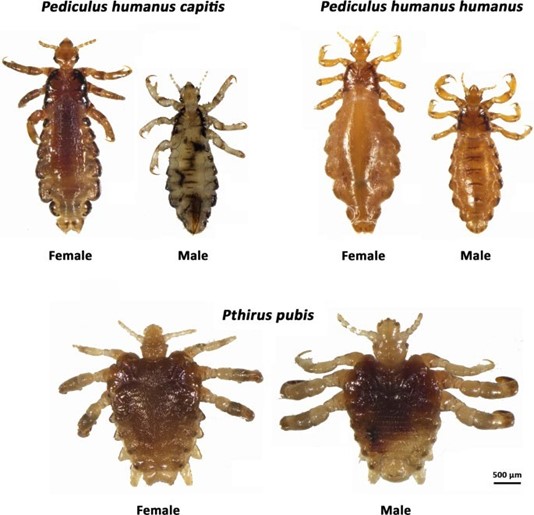A nurse in a provider's office is reinforcing teaching with the parents of a school-age child who has an active case of Pediculosis humanus capitis. Which of the following should the nurse include in the teaching?
Apply a topical corticosteroid ointment to the scalp.
Soak hair brushes and combs in soapy water.
Wash the bed linens in hot water
Clean the child's toys with 1:10 bleach solution.
None
None
The Correct Answer is C
Answer: C
Rationale:
A) Apply a topical corticosteroid ointment to the scalp: Corticosteroids are not indicated for the treatment of Pediculosis capitis (head lice). The treatment focuses on eliminating the lice and nits, typically through pediculicide medications like permethrin or ivermectin. Corticosteroids are used to reduce inflammation and itching, but they do not kill the lice or their eggs.
B) Soak hair brushes and combs in soapy water: Soaking hair brushes and combs in soapy water alone is not sufficient to kill lice. Items such as hair brushes should be soaked in hot water (130°F or higher) for at least 5-10 minutes to ensure any lice or nits present are killed. This is a critical step to prevent reinfestation.
C) Wash the bed linens in hot water: Washing bed linens in hot water (130°F or higher) is essential to eliminate lice and nits that may have transferred onto bedding. This prevents the spread and recurrence of lice. Items that cannot be washed should be sealed in a plastic bag for 2 weeks to kill the lice.
D) Clean the child's toys with a 1:10 bleach solution: Lice are spread through direct contact and cannot live on inanimate objects for long periods. Cleaning toys with bleach is unnecessary for lice removal and can be harmful to the toys or the child if not properly rinsed.

Nursing Test Bank
Naxlex Comprehensive Predictor Exams
Related Questions
Correct Answer is B
Explanation
The charge nurse should explain to the assistive personnel (AP) that one of the responsibilities of a licensed practical nurse (LPN) is providing direct client care. LPNs work under the supervision of registered nurses (RNs) and are trained to deliver basic nursing care to clients. This includes tasks such as administering medications, monitoring vital signs, dressing wounds, assisting with activities of daily living (ADLs), and reporting any changes in the client's condition to the RN.
The other options are not typically within the scope of practice for an LPN:
a. Coordinating client care: The coordination of client care is primarily the responsibility of the RN. While LPNs may contribute to the coordination of care by providing input and collaborating with the healthcare team, the overall coordination is usually managed by the RN.
c. Assessing a client's health status: Assessing a client's health status is a role primarily performed by RNs. LPNs may gather data and contribute to the assessment process, but the comprehensive assessment and interpretation of data is typically the responsibility of the RN.
d. Identifying specific client health problems: Identifying specific client health problems and formulating nursing diagnoses is part of the RN's role. LPNs may assist in collecting data and providing input, but the identification and formulation of nursing diagnoses are within the scope of practice of the RN.
Correct Answer is B
Explanation
Answer: B. Stiff posture
Rationale:
A. Lip-smacking : Lip-smacking is not typically an indication of pain in newborns. It may be associated with hunger or neurological responses, but it does not directly indicate discomfort or pain caused by shoulder dystocia or other injuries.
B. Stiff posture : A stiff posture can indicate pain in newborns, as they often exhibit hypertonicity or rigidity when experiencing discomfort. This response is a protective mechanism and may suggest the newborn is reacting to pain from potential nerve or tissue damage caused by shoulder dystocia.
C. Weak cry : While a weak cry may indicate neurological or respiratory distress, it is not a specific sign of pain. In the context of shoulder dystocia, a weak cry could reflect complications such as brachial plexus injury but does not directly signify the presence of pain.
D. Tongue-darting : Tongue-darting is more commonly associated with neurological issues or feeding difficulties rather than pain. It is not a typical behavioral response to discomfort or injury in newborns experiencing complications like shoulder dystocia.
Whether you are a student looking to ace your exams or a practicing nurse seeking to enhance your expertise , our nursing education contents will empower you with the confidence and competence to make a difference in the lives of patients and become a respected leader in the healthcare field.
Visit Naxlex, invest in your future and unlock endless possibilities with our unparalleled nursing education contents today
Report Wrong Answer on the Current Question
Do you disagree with the answer? If yes, what is your expected answer? Explain.
Kindly be descriptive with the issue you are facing.
